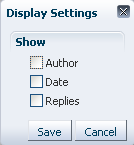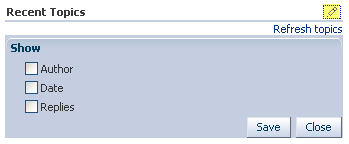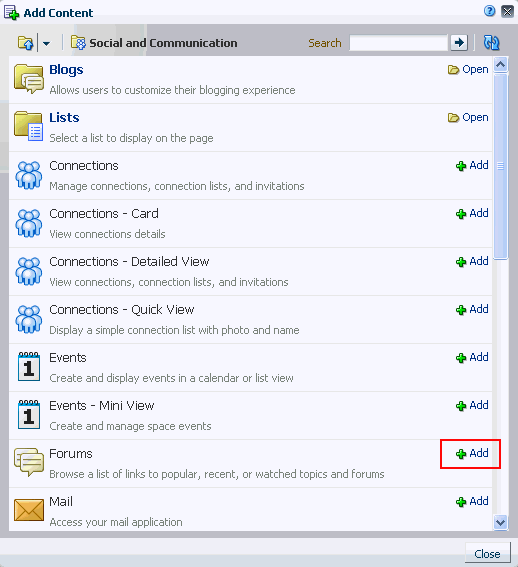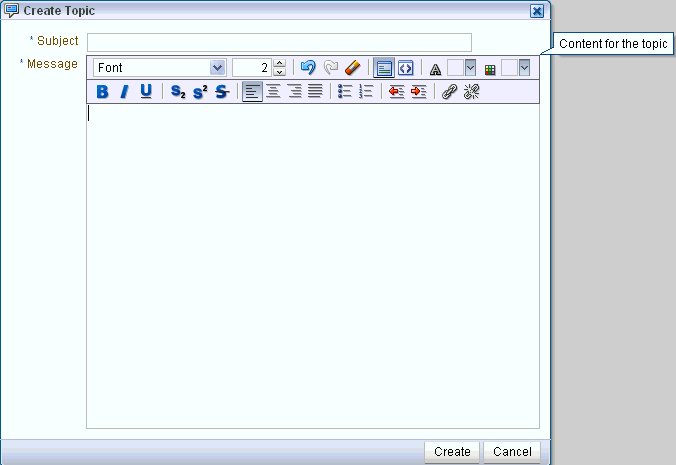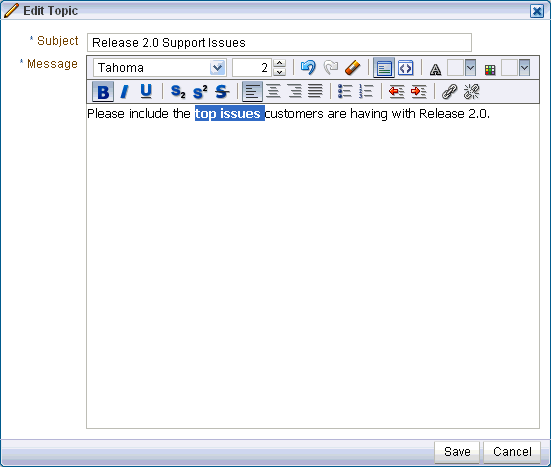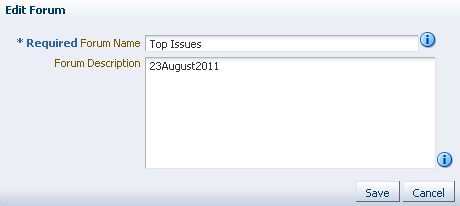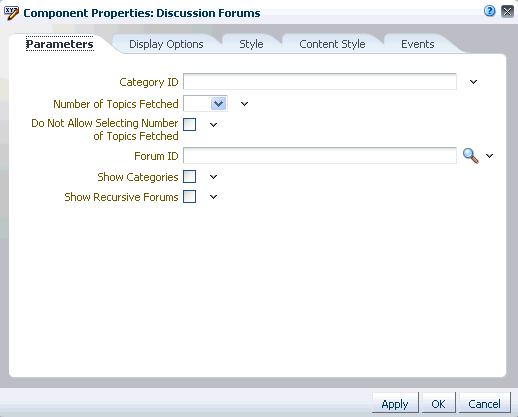62 Working with the Discussions Service
This chapter describes how to use the features provided through the Discussions service. The Discussions service provides a means of creating and participating in text-based discussions with other members of a space. Use Discussions service task flows to create forums, post questions, and search for answers. Discussion forums additionally provide the means to preserve and revisit discussions.
This chapter includes the following sections:
-
Section 62.1, "What You Should Know About the Discussions Service"
-
Section 62.3, "Setting Discussions Service Task Flow Properties"
This chapter is intended for users who want to view, create, and manage space discussion forums and topics. To perform discussion-related tasks, you must have appropriate permissions: Create, Edit, and Delete Discussions, Create and Edit Discussions, or View Discussions. For more information, see Section 54.2.1.2, "Understanding Permissions and Permission Models in a Space."
Note:
Tasks discussed in this chapter are not available if the Discussions service is not enabled in the current space.
62.1 What You Should Know About the Discussions Service
You can use the Discussions service to post, respond to, and preserve topical information in discussion forums scoped to spaces or to entire applications. Users post topics to a discussion forum, and other users post information relevant to those topics. All of this information is preserved within the forum.
The back-end server that provides the Discussion service (Oracle WebCenter Portal's Discussion Server) manages content in a hierarchy. At the top of the hierarchy are categories, below that are forums, and then topics. Where categories are exposed in your application, authorized users can create multiple forums within a given scope and multiple topics under those forums. Where categories are not exposed, authorized users can create multiple topics under one forum within a given scope.
A new space is assigned a single discussion forum by default. Space moderators can allocate multiple forums to a space if required, as described in Section 6.2, "Configuring Discussion Forum Options for the Spaces Application." However, only users who are system administrators on Oracle WebCenter Portal's Discussion Server can switch from a single forum to multiple forums in a space.
The Discussions service is scoped to spaces. That is, you can create forums and topics only within the context of a space. You can view and participate in discussions in both spaces and Home spaces, depending on your application permissions.
Access to discussions is influenced by application security. The Spaces application is, by default, a secure application. Users can access discussions according to the permissions they are granted by their specific user roles within a given space.
Scoping additionally limits the users who can view and participate in discussions. For example, only members of the Finance space can view discussions that transpire in Finance space forums.
To expose a discussion forum to a specific set of users, you must add just those users as members of the space where you hold the forum (for more information, see Section 53.14.4, "Granting Spaces Users Access to a Space"). To open a discussion to all users, you must create a publicly-accessible space (for more information, see Section 53.14.5, "Granting Public Access to a Space").
Most Discussions service task flows provide configuration settings for specifying which forum content to show. This is of particular use in Home spaces, which exist outside a specific space scope (for more information, see Section 62.3, "Setting Discussions Service Task Flow Properties").
Note:
You can add a Discussions task flow to your page from the Catalog dialog in Oracle Composer. For information about adding a task flow, see Section 18.5, "Adding a Component to a Page."
However, all instances of the Discussions task flow in an application run against the same back end and it serves no purpose to add multiple Discussions task flow instances. This is true for all service task flows that require connections to back-end servers, for example, task flows from IMP, Announcements, and Mail services.
The Discussions service provides a wide variety of task flows for viewing and participating in discussions. These include:
-
Discussion Forums provides controls for creating discussion forums; creating, replying to, and managing discussion forum topics; and selecting watched forums and watched topics (Figure 62-1).
In WebCenter Portal: Spaces, the Discussion Forums task flow is additionally exposed on a Discussions page. You cannot add Discussion Forums to a Home space.
-
Forums - Quick View provides a means of accessing all possible views of a particular space's discussions: Recent Topics, Popular Topics, Watched Topics, and Watched Forums (Figure 62-2).
The Forums - Quick View task flow also provides controls for determining the data to show in addition to the forum or topic title. Click the Personalize icon (pencil) in the task flow toolbar to open the Display Settings (Figure 62-3).
The available display settings vary according to the option currently selected on the task flow Display Options menu (Figure 62-4).
For example, when Recent Topics is selected on the menu, the Display Settings dialog offers the options Author, Date, and Replies. When the task flow displays Watched Forums, the Display Settings dialog offers the options Date and Topics.
The Forums - Quick View task flow is available for placement on any application page, regardless of whether the page is scoped to a Home space or space.
-
Popular Topics (Figure 62-5) provides a look at the most frequently viewed discussion topics in all the discussion forums in a given space.
The Popular Topics task flow also provides controls for determining the data to show in addition to the topic title. Click the Personalize icon in the task flow header to open a panel with controls for selecting the type of additional data to show (Figure 62-6).
The Popular Topics task flow is available for placement on any application page, regardless of whether the page is scoped to a Home space or space.
-
Recent Topics (Figure 62-7) provides a look at the most recently accessed discussion topics in all the discussion forums in a given space.
Access to space discussion topics is restricted to those spaces of which you are a member.
The Recent Topics task flow also provides controls for determining the data to show in addition to the topic title. Click the Personalize (pencil) icon in the task flow header (Figure 62-8) to open a panel with controls for selecting the type of additional data to show.
The Recent Topics task flow is available for placement on any application page, regardless of whether the page is scoped to a Home space or space.
-
Watched Forums (Figure 62-9) provides a means of viewing all discussion forums you have selected to watch from a particular space or from all spaces.
The Watched Forums task flow also provides controls for determining the data to show with the topic title. Click the Personalize icon in the task flow header (Figure 62-10) to open a panel with controls for specifying the type of additional data to show. See Section 62.2.4, "Watching Forums and Topics."
The Watched Forums task flow is available for placement on any application page, regardless of whether the page is scoped to a Home space or space.
-
Watched Topics (Figure 62-11) provides a cohesive view of all the topics you have selected to watch from a particular space or from all spaces.
The Watched Topics task flow also provides controls for determining the data to show with the topic title. Click the Personalize icon in the task flow header (Figure 62-12) to open a panel with controls for specifying the type of additional data to show. See Section 62.2.4, "Watching Forums and Topics."
The Watched Topics task flow is available for placement on any application page, regardless of whether the page is scoped to a Home space or space.
Note:
All instances of the Mail task flow in an application run against the same mail server and it serves no purpose to add multiple Mail task flow instances. This is true for all service task flows that require connections to back-end servers, for example, task flows from Announcements, Mail, and IMP services.
The Discussions service is tightly integrated with other services, such as Links and Mail. For example, all mail sent to a space distribution list can additionally be posted to that space's default discussion forum. The space moderator must select Monitor Incoming Mail in the space settings for the Discussions service (see Section 53.10.4, "Publishing Space Mail in a Discussion Forum"). Every discussion topic provides the opportunity to link from the topic to another space item, such as a document or an announcement. (For information about the Mail service, see Chapter 67, "Working with the Mail Service." For information about the Links service, see Chapter 65, "Working with the Links Service.")
62.2 Working with Discussions Service Task Flows
The Discussions service task flows expose all of the functionality available from the Discussions service. The Discussion Forums is the most feature-rich task flow, providing controls for creating and managing discussion forums and posting and managing discussion topics and replies. The other task flows are useful windows into discussion forum content. They provide different views of the discussion forums and topics available to a particular space or all spaces.
Note:
For information about configuring a Discussions service task flow to display the discussions from a particular space or from all spaces, see Section 62.3, "Setting Discussions Service Task Flow Properties."
Most of the subsections in this section describe tasks you can accomplish through the Discussion Forums task flow. When you can use other task flows to perform the described actions, this is noted.
This section contains the following subsections:
-
Section 62.2.1, "Adding a Discussions Service Task Flow to a Page"
-
Section 62.2.2, "Creating and Managing Forum Topics and Replies"
-
Section 62.2.3, "Showing and Hiding Additional Discussion Forum Information"
62.2.1 Adding a Discussions Service Task Flow to a Page
To add a Discussions service task flow to a page in a Spaces application:
-
Open the page in edit mode.
See Also:
For more information, see Section 18.1, "Entering and Exiting Composer."
-
Click Add Content in the target region to open the Resource Catalog.
-
Navigate to the section of the Resource Catalog that provides access to the discussions task flows.
Tip:
The presence or location of this section depends on how the Resource Catalog is configured. In the default Resource Catalog, next to Social and Communication, click Open.
-
Click Add next to the task flow that you want to add to your page (Figure 62-14).
Note:
Not all discussions task flows are available in the default Resource Catalog provided out-of-the-box with Spaces, so you will only see entries for these task flows if they have been added to a custom Resource Catalog that has been made available to the page.
For more information, see Chapter 16, "Working with Resource Catalogs," specifically Section 16.3.1.2, "Adding Resources" (in the Add Resource Catalog Item dialog, select Task Flows, then scroll to Discussions for a list of all available task flows).
62.2.2 Creating and Managing Forum Topics and Replies
The life of a discussion forum takes place in its topics and replies. There users can ask questions, post information, exchange ideas, and otherwise communicate in interesting and useful ways.
This section describes how to work with discussion forum topics and replies. It contains the following subsections:
62.2.2.1 Posting a New Forum Topic
When you consider discussion forums hierarchically, the forum is the top container and topics are the next level down. Each posted topic can have subordinate replies, and the replies themselves may have replies (Figure 62-15).
Figure 62-15 A Posted Topic and a Reply to the Topic

Description of "Figure 62-15 A Posted Topic and a Reply to the Topic"
This section describes how to post topics using the Discussion Forums task flow. For information about replying to a posted topic, see Section 62.2.2.2, "Replying to Topic Posts."
To post a topic under a discussion forum:
-
Go to the Discussion Forums task flow in which to post a topic, and click Create Topic (Figure 62-16).
The Create Topic dialog opens (Figure 62-17).
-
In the Subject field, enter the topic subject.
Enter up to 255 characters.
-
In the Message field, enter your post about the topic.
Enter up to 4000 characters.
-
Click Create.
The newly-posted topic appears under the selected forum in Discussion Forums. Click the topic subject to view the message (Figure 62-18).
Figure 62-18 A New Discussion Forum Topic

Description of "Figure 62-18 A New Discussion Forum Topic"
62.2.2.2 Replying to Topic Posts
This section describes how to reply to topic posts through the Discussion Forums, though you can reply to a topic post through any other Discussions service task flow.
By default, the Discussion Forums task flow is exposed as the Discussions page.
To reply to topic posts:
-
Go to the Discussions task flow in which to read and reply to topic posts, and click the relevant topic (Figure 62-19).
The selected topic opens.
-
Click Reply Topic (Figure 62-20).
The Reply Topic dialog opens (Figure 62-21).
-
In the Subject field, either leave the text as is or revise it.
Enter up to 255 characters.
-
In the Message text box, enter your reply to the topic.
Enter up to 4000 characters.
-
Click Reply.
Your reply appears below the main topic post (Figure 62-22).
To post a reply to a reply, click the Reply to message icon (Figure 62-23) and follow the steps described in this section (starting with step 5).
62.2.2.3 Viewing Topic Posts and Replies
With the Discussion Forums task flow, topics and replies to the topic open directly in the Discussions Forums task flow. To navigate back up the forum hierarchy, click the breadcrumbs that display above the topic reply area (Figure 62-24).
With all the other Discussions service task flows, topics open in a separate window (Figure 62-25).
Figure 62-25 Viewing a Topic in the Discussions - Popular Topics Task Flow
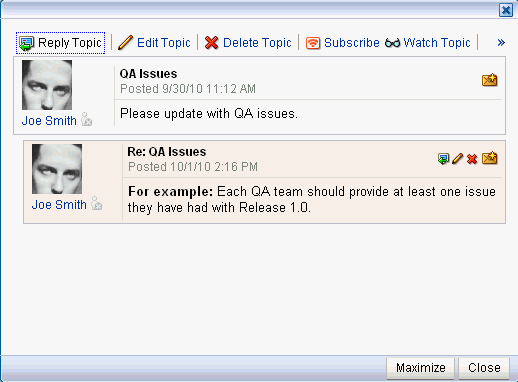
Description of "Figure 62-25 Viewing a Topic in the Discussions - Popular Topics Task Flow"
To return to the task flow main view, click Close button in the window.
62.2.2.4 Editing Topics and Replies
After you post a topic or a reply, you retain the option of returning to it and revising its content. Only you and space moderators can edit your replies. This section describes how.
To edit a topic or a reply:
-
Go the Discussion Forums task flow that displays the topic or reply you want to edit, and click the relevant topic.
The selected topic opens.
-
Your next step depends on whether you want to edit a topic or a reply:
-
To edit the topic, click the Edit Topic link at the top of the topic screen (Figure 62-26).
-
To edit a reply, click the Edit message icon (pencil) associated with the reply (Figure 62-27).
The Edit Topic (or Edit Message) dialog opens (Figure 62-28).
-
-
Revise the topic (up to 255 characters) or reply (up to 4000 characters).
-
Click Edit in the Edit Topic dialog, or click Reply in the Edit Reply dialog.
Your changes are posted to the forum.
62.2.2.5 Deleting Topic Posts and Replies
When you delete a topic, the original topic post and all of its subordinate replies are deleted. When you delete a reply, you can select to delete the original reply as well as all of its subordinate replies or to delete only this message and keep its replies.
The steps to delete topics and replies are similar.
Note:
To delete a topic post or reply, you must have created it or you must have access equivalent to space moderator.
To delete a topic or a reply:
-
Go to the Discussion Forums task flow that displays the topic or reply you want to delete, and click the relevant topic (Figure 62-29).
The selected topic opens.
-
Your next step depends on whether you want to delete a topic or a reply:
-
To delete a topic, click the Delete Topic link at the top of the topic screen (Figure 62-30).
A Delete Topic confirmation dialog opens (Figure 62-31).
-
To delete a reply, click the Delete message icon associated with the reply (Figure 62-32).
A Delete Message confirmation dialog opens, letting you select if you want to delete this message and all its replies or delete only this message. (Figure 62-33).
-
-
Click Delete to delete your selection.
62.2.2.6 Selecting the Number of Topics or Forums to Display
You can decide how many topics or forums to display; for example, 10, 25, 50, 75, or 100 (Figure 62-34).
For example, if you choose to display 10 topics, and if there are more than 10 topics available, then you click the More link to see the next 10 topics, and so on.
When the Do Not Show More Link task flow parameter is set to true, the More link does not appear. For more information, see Section 62.3, "Setting Discussions Service Task Flow Properties."
62.2.2.7 Switching Between Topic View Modes
You have the option of viewing a topic and all of its replies in a hierarchical, indented mode or a flat, unindented mode. The hierarchical mode (Figure 62-35) uses indenting to indicate whether a reply is to the topic or to another reply.
For example, in Figure 62-35 the first entry is the main topic, the second is a reply to the topic, and so on.
The flat mode (Figure 62-36) makes no such distinctions.
All Discussion task flows that show topics and replies in the same screen provide view mode options.
To switch between topic view modes:
-
Go to the Discussions task flow that contains the topic you want to view, and click the topic.
-
From the Show dropdown list, select either Flat or Hierarchical.
The topic view rerenders according to your selection.
62.2.3 Showing and Hiding Additional Discussion Forum Information
Most discussions task flows provide personalization settings for determining information to show in addition to the forum or topic title (the Discussion Forums task flow does not provide such settings). Additional information can include forum or topic author, creation date, and replies or topics.
How you set these display settings is personal, affecting only your view of a task flow instance. How you access these display settings varies slightly from task flow to task flow.
This section describes how to configure display settings for Discussions service task flows. It contains the following subsections:
-
Section 62.2.3.1, "Showing or Hiding Information in the Forums - Quick View Task Flow"
-
Section 62.2.3.2, "Showing or Hiding Information in the Popular Topics Task Flow"
-
Section 62.2.3.3, "Showing or Hiding Information in the Recent Topics Task Flow"
-
Section 62.2.3.4, "Showing or Hiding Information in the Watched Forums Task Flow"
-
Section 62.2.3.5, "Showing or Hiding Information in the Watched Topics Task Flow"
62.2.3.1 Showing or Hiding Information in the Forums - Quick View Task Flow
To show or hide additional information in the Discussions - Quick View task flow:
-
Go to the Discussions - Quick View task flow where you want to configure display settings.
-
Click the Select the data to display icon in the task flow toolbar (Figure 62-37).
The Display Settings dialog opens (Figure 62-38).
-
Select the data you want to show, or deselect the check box of data you want to hide. Select or deselect one or more from:
-
Author—The user name of the person who created the forum or topic
-
Date—The date the forum or topic was last updated
-
Replies—The replies associated with the topic (for Watched Forums, this displays forums)
-
-
Click Save to save your changes and close the dialog.
62.2.3.2 Showing or Hiding Information in the Popular Topics Task Flow
To show or hide additional information in the Popular Topics task flow:
-
Go to the Popular Topics task flow where you want to show or hide additional information.
-
Click the Personalize icon in the task flow header.
This opens a panel where you can select or deselect additional data (Figure 62-39).
-
Select the data you want to show, or deselect the check box of data you want to hide. Select or deselect one or more from:
-
Author—The user name of the person who posted the topic
-
Date—The date the topic was last updated
-
Replies—The replies associated with the topic
-
-
Click Save to save your changes and close the panel.
62.2.3.3 Showing or Hiding Information in the Recent Topics Task Flow
To show or hide additional information in the Recent Topics task flow:
-
Go to the Recent Topics task flow where you want to show or hide additional information.
-
Click the Personalize icon in the task flow header.
This opens a panel where you can select or deselect additional data (Figure 62-40).
-
Select the data you want to show, or deselect the check box of data you want to hide. Select or deselect one or more from:
-
Author—The user name of the person who posted the topic
-
Date—The date the topic was last updated
-
Replies—The replies associated with the topic
-
-
Click Save to save your changes and close the panel.
62.2.3.4 Showing or Hiding Information in the Watched Forums Task Flow
To show or hide additional information in the Watched Forums task flow:
-
Go to the Watched Forums task flow where you want to show or hide additional information.
-
Click the Personalize (pencil) icon in the task flow header.
This opens a panel where you can select or deselect additional data (Figure 62-41).
-
Select the data you want to show, or deselect the check box of the data you want to hide. Select or deselect one or more from:
-
Date—The date the forum was last updated
-
Topics—The topics associated with the forum
-
-
Click Save to save your changes and close the panel.
62.2.3.5 Showing or Hiding Information in the Watched Topics Task Flow
To show or hide additional information in the Watched Topics task flow:
-
Go to the Watched Topics task flow where you want to show or hide additional information.
-
Click the Personalize icon in the task flow header.
This opens a panel where you can select or deselect additional data (Figure 62-42).
-
Select the data you want to show, or deselect the check box of the data you want to hide. Select or deselect one or more from:
-
Author—The user name of the person who posted the topic
-
Date—The date the topic was last updated
-
Replies—The replies associated with the topic
-
-
Click Save to save your changes and close the panel.
62.2.4 Watching Forums and Topics
Watching discussion forums and topics provides a convenient means of keeping a close eye on the information most current and relevant to your efforts. The forums and topics you choose to watch are personal, in that your selections appear on your view of watch lists. No other user is affected by the forums and topics you choose to watch.
When a user places a watch on a forum or a topic, whenever users add to that forum or topic, in addition to it appearing in the user's watched forums or topics list, the user receives a mail notification.
In Spaces, all watched forums and topics are accessible from the Discussions panel in the quick view. All watched forums and topics are accessible from the Forums task flow. The Watched Forums and Watched Topics task flows provide more focussed views of watched forums or watched topics.
This section includes information about how to add, view, and manage watched topics and forums. It contains the following subsections:
-
Section 62.2.4.1, "Adding a Discussion Forum or Topic to Your Watch List"
-
Section 62.2.4.2, "Removing a Discussion Forum or Topic from a Watch List"
-
Section 62.2.4.3, "Viewing Watched Forums and Topics from the Quick View"
62.2.4.1 Adding a Discussion Forum or Topic to Your Watch List
To add a discussion forum or topic to your watch list:
-
Go to the discussion forum or topic you want to add to your watch list.
-
The next step depends on whether you want to watch a forum or a topic:
-
To watch a forum, click the Watch Forum link at the top of the forum (Figure 62-43).
-
To watch a topic, click the Watch Topic link at the top of the topic (Figure 62-44).
-
The watched forum or topic is listed on all Watched Forums or Watched Topics lists, for example, on the Discussions panel in the quick view (Figure 62-45) and in Watched Forums and Watched Topics task flows.
Figure 62-45 Watched Forums on the Discussions Panel in the Quick View

Description of "Figure 62-45 Watched Forums on the Discussions Panel in the Quick View"
62.2.4.2 Removing a Discussion Forum or Topic from a Watch List
To remove a discussion forum or a discussion topic from your watch list:
-
Go to the discussion forum or topic you want to remove from your watch list.
-
Click the Remove Watch icon on the forum or topic (Figure 62-46).
The selected item is removed from your forum or topic watch list.
62.2.4.3 Viewing Watched Forums and Topics from the Quick View
To view a watched forum or topic from the Quick View:
-
From the Forums - Quick View task flow, set the panel display option to Watched Forums or Watched Topics (Figure 62-47).
Figure 62-47 Watched Forums on the Forums - Quick View

Description of "Figure 62-47 Watched Forums on the Forums - Quick View"
-
Click the link to the discussion forum or forum topic you want to view.
The forum or topic opens (Figure 62-48).
Figure 62-48 A Watched Forum Opened from the Quick View
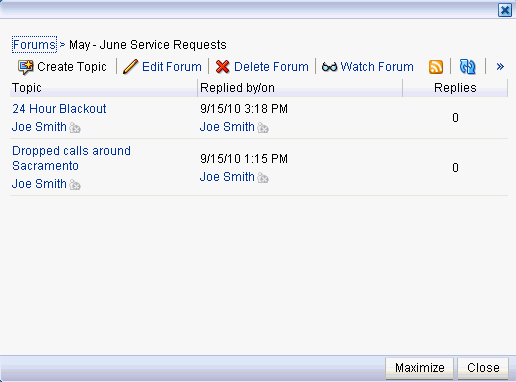
Description of "Figure 62-48 A Watched Forum Opened from the Quick View"
62.2.5 Sending Mail from Discussion Topics
Each discussion topic in has an associated Send Mail icon in its toolbar (Figure 62-49). Click the Send Mail icon to initiate a mail message containing the discussion text, location, author, and date it was created. This feature makes it easy for you to communicate interesting discussions to others.
The WebCenter Portal administrator determines the mail client to use with the Send Mail icon. If a local mail client was set, then a plain text message opens. If WebCenter Portal's Mail service was set as the mail client, then the HTML Mail Compose dialog opens. With either mail client, you can add or edit the standard, perpetuated message before sending.
62.2.6 Creating a Discussion Forum
Create discussion forums on the Discussions page or with the Discussion Forums task flow.
To create forums, you must be the space moderator.
Note:
A new space is assigned a single discussion forum by default. Space moderators can allocate multiple forums to a space if required, as described in Section 6.2, "Configuring Discussion Forum Options for the Spaces Application."
To create a discussion forum:
-
Go to the Discussions page. If multiple forums have been enabled, then you see a Forums link pointing to the default forum (Figure 62-50).
-
Click the Forum link, and then the Create Forum button (Figure 62-51).
The Create Forum dialog opens (Figure 62-52).
-
In the Forum Name field, enter a name for the discussion forum.
Enter up to 255 characters.
-
Optionally, in the Forum Description text box, enter a description of the discussion forum.
Enter up to 4000 characters.
-
Click Create.
The new forum appears on the list of forums (Figure 62-53). Click a forum name to view forum content.
Figure 62-53 New Discussion Forum (May Service Requests)

Description of "Figure 62-53 New Discussion Forum (May Service Requests)"
62.2.7 Editing the Forum Name and Description
To rename a discussion forum or revise its description:
-
Go to the Discussions page or the Discussions Forums task flow, and click the forum you want to edit (Figure 62-54).
The Edit Forum dialog opens (Figure 62-55).
-
Optionally, in the Forum Name field enter a new name for the discussion forum.
-
Optionally, in the Forum Description text box, revise the description of the discussion forum.
Enter up to 4000 characters.
-
Click Save.
62.3 Setting Discussions Service Task Flow Properties
The Discussions service task flows have associated properties, which users with sufficient privileges can access through the Component Properties dialog in Oracle Composer (Figure 62-56).
For information about accessing the Component Properties dialog, see Section 18.6.2, "Setting Properties on a Component."
The following sections provide information about properties of the Discussions service task flows and describe the properties on the Parameters tab.
62.3.1 What You Should Know About the Discussions Service Task Flow Properties
The properties on the Parameters tab of the Component Properties dialog control the default task flow content. For descriptions of the parameters on this tab, see Section 62.3.2, "Discussions Service Task Flow Parameters." For some task flows, parameters on this tab facilitate the wiring of the task flow to page parameters and page definition variables. For more information, see Chapter 22, "Wiring Pages, Task Flows, Portlets, and UI Components."
Changes to the properties on the Display Options, Style, and Content Style tabs affect the appearance and behavior of the task flow. These properties are common to all task flows. For more information, see Section 18.6, "Modifying Page Components."
The content of the Events tab depends on the events supported by the task flow. For more information, see Section 18.6.7, "Working with Component Contextual Events."
The Child Components tab displays all of the components contained within the current component. It provides controls for rearranging, showing, and hiding child components. Not all components contain children. So this tab may be omitted. For more information, see Section 18.6.5, "Working with Child Components."
All properties on the Parameters and Display Options tabs provide access to an Expression Language (EL) editor, which you can use to select or specify a variable value instead of a constant value. Click the Edit icon next to a property field to open the editor. For more information about using the editor and for descriptions of common EL expressions, see Appendix B, "Expression Language (EL) Expressions."
Note:
Wherever you enter EL on the generic Display Options tab in the Component Properties dialog, the entry is automatically validated. If the EL syntax is invalid, an error appears and the value is neither applied nor saved. Generic Display Options are those cataloged in Table 18-1.
EL validation is not performed on non-generic display options.
62.3.2 Discussions Service Task Flow Parameters
Table 62-1 describes the properties that are unique to the Discussions task flows.
Table 62-1 Discussions Service Task Flow Parameters
| Parameter | Description | Task Flow |
|---|---|---|
|
On the discussions server, the category ID under which a given set of forums is managed For the Forums task flow, use this parameter to specify the set of forums to present. For all other discussions task flows, use this parameter to specify the parent ID of the topics to show by default. If omitted, the value defaults to the Category ID associated with the current space. In Home spaces, it takes the root Category ID. Use the following EL expression to return the Category ID of a named space:
#{sessionContext['oracle.webcenter.collab.forum'].groupInfo['SpaceName'].categoryId}
Enter the space internal name (not the space display name) for the variable |
|
|
|
On the discussions server, the identifier under which topics are managed Use this parameter to identify the default forum to show in the task flow. Use the following EL expression to return the forum ID of a named space:
#{sessionContext['oracle.webcenter.collab.forum'].groupInfo['SpaceName'].forumId}
Enter the space internal name (not the space display name) for the variable |
|
|
|
A means of showing or hiding the task flow personalization feature (see Section 62.2.3, "Showing and Hiding Additional Discussion Forum Information") |
|
|
|
Determines if you show forums either in a category only or in subcategories.
|
Forums |
|
|
A means of showing the forums grouped under the Category ID or the topics specified under the Forum ID.
This parameter value works in combination with other parameters. |
Forums |
|
|
If selected, then users are not allowed to change the number of visible topics. |
Discussion Forums |
|
|
Sets the number of visible topics. |
|
|
|
Sets the number of visible recent topics. |
Recent Topics |
|
|
Sets the number of visible watched forums. |
Watched Forums |
|
|
Sets the number of visible watched topics. |
Watched Topics |
|
|
If selected, then the More link (to see more topics or forums) is not visible. |
|


